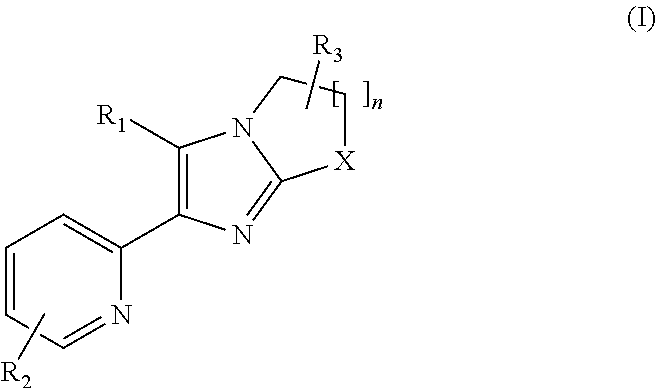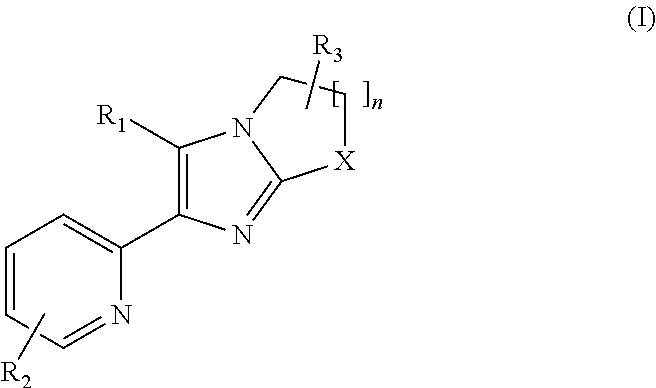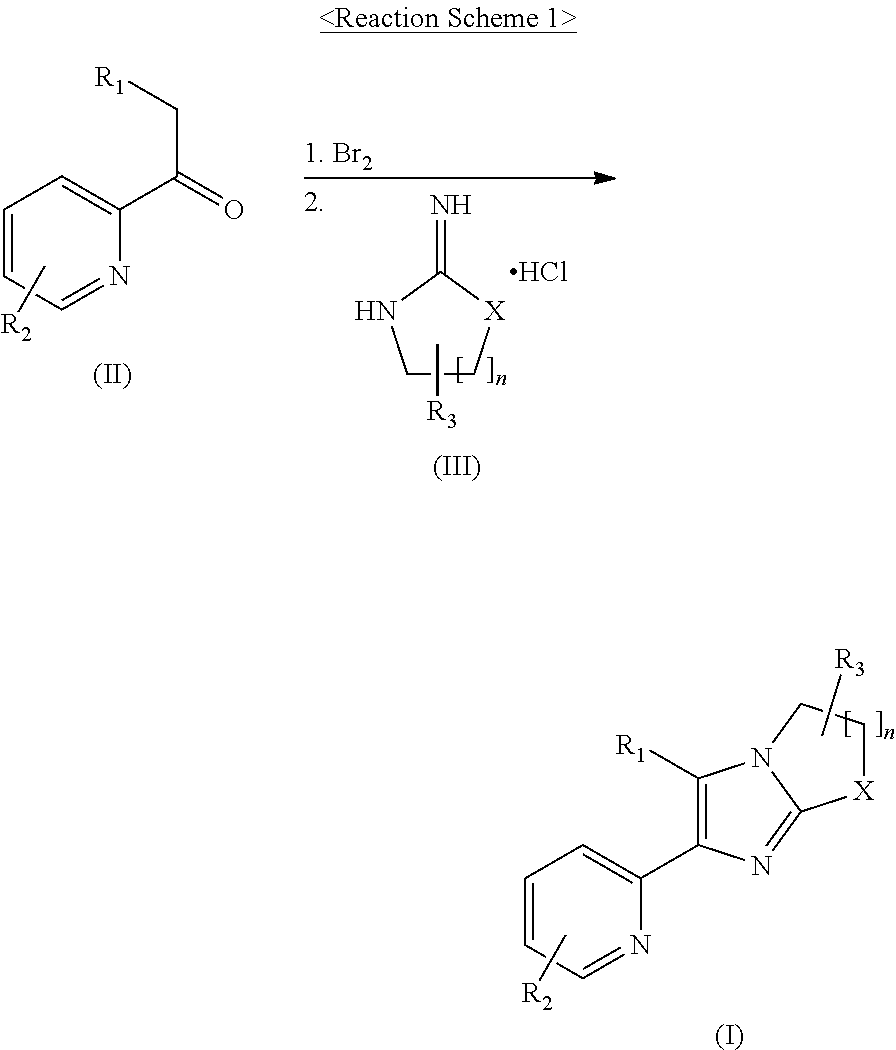2-pyridyl substituted imidazoles as alk5 and/or alk4 inhibitors
a technology of imidazole and alk4, which is applied in the direction of drug composition, metabolism disorder, extracellular fluid disorder, etc., can solve the problems of graft loss and complex organ transplantation
- Summary
- Abstract
- Description
- Claims
- Application Information
AI Technical Summary
Benefits of technology
Problems solved by technology
Method used
Image
Examples
example 1
EXAMPLE 1
Preparation of 1-[6-(6-methyl-pyridin-2-yl)-5-quinoxalin-6-yl-2,3-dihydro-imidazo[1,2-a]imidazol-1-yl]-ethanone
[0208]
[0209]1,2-Dibromoethane (56 μL, 0.65 mmol) was added to a mixture of N-[5-(6-methyl-pyridin-2-yl)-4-quinoxalin-6-yl-1H-imidazol-2-yl]-acetamide (150 mg, 0.44 mmol) and K2CO3 (304 mg, 2.20 mmol) in CH3CN (6 mL) at 80° C. 1,2-dibromoethane (25 μL, 0.29 mmol) was added thereto in three portions every 2 hours, and the reaction mixture was stirred for 15 hours. After cooling to room temperature, the mixture was filtered through celite, washed with CH2Cl2, and concentrated under a reduced pressure. The residue was purified by MPLC on NH silica gel eluting with CH2Cl2 to obtain the title compound (36.7 mg, 23%) as a yellow solid.
[0210]MS (ESI) m / z 371.68 (MH+).
[0211]1H NMR (300 MHz, CDCl3) δ 8.84 (d, 2H), 8.15 (d, 1H), 8.03 (d, 1H), 7.97 (dd, 1H), 7.62 (d, 1H), 7.55 (t, 1H), 7.00 (d, 1H), 4.55 (t, 2H), 4.27 (t, 2H), 2.76 (s, 3H), 2.36 (s, 3H).
example 2
Preparation of 6-[2-(6-methyl-pyridin-2-yl)-6,7-dihydro-5H-imidazo[1,2-a]imidazol-3-yl]-quinoxaline
[0212]
[0213]1N NaOH (97 μL, 0.097 mmol) was added to a suspension of 1-6-(6-methyl-pyridin-2-yl)-5-quinoxalin-6-yl-2,3 -dihydro- imidazo [1,2-a]imidazol-1-yl-ethanone (Example 1, 30 mg, 0.08 mmol) in MeOH (2 mL), and the mixture was stirred at 60° C. for 2 hours. After cooling to room temperature, the reaction mixture was concentrated under a reduced pressure. The residue was purified by
[0214]MPLC on NH silica gel eluting with 1% MeOH / CH2Cl2 to obtain the title compound (18.7 mg, 71%) as a yellow solid.
[0215]MS (ESI) m / z 329.64 (MH+).
[0216]1H NMR (300 MHz, CDCl3) δ 8.82 (d, 1H), 8.80 (d, 1H), 8.12 (t, 1H), 7.98 (m, 2H), 7.50 (d, 1H), 7.49 (t, 1H), 6.97 (dd, 1H), 4.57 (br s, 1H), 4.24 (m, 2H), 4.09 (t, 2H), 2.39 (s, 3H).
example 3
Preparation of 6-12-(6-methyl-pyridin-2-yl)-5,6,7,8-tetrahydro-imidazo[1,2-alpyrimidin-3-yl]-quinoxaline
[0217]
[0218]A solution of bromine (0.117 mL, 2.28 mmol) in 1,4-dioxane (2 mL) were slowly added to a stirred solution of 1-(6-methyl-pyridin-2-yl)-2-quinoxalin-6-yl-ethanone (600 mg, 2.28 mmol) in 1,4-dioxane (10 mL) After stirring for 1 hour, the reaction mixture was partitioned between t-BuOMe and water. The organic layer was separated and the aqueous layer was neutralized with a NaHCO3 solution. The organic layer was mixed with the aqueous layer and separated. The aqueous layer was extracted twice with CH2Cl2, dried over anhydrous Na2SO4, filtered and evaporated to dryness under a reduced pressure to obtain the bromide (877 mg, 112%). Tetrahydro-pyrimidin-2-ylideneamine hydrochloride (330 mg, 2.44 mmol) and K2CO3 (337 mg, 2.44 mmol) were added to a solution of the bromide (278 mg, 0.81 mmol) in DMF (3 mL), and the mixture was stirred at 80° C. for 5 hours. After cooling to room...
PUM
| Property | Measurement | Unit |
|---|---|---|
| molecular weight | aaaaa | aaaaa |
| molecular weight | aaaaa | aaaaa |
| molecular weight | aaaaa | aaaaa |
Abstract
Description
Claims
Application Information
 Login to View More
Login to View More - R&D
- Intellectual Property
- Life Sciences
- Materials
- Tech Scout
- Unparalleled Data Quality
- Higher Quality Content
- 60% Fewer Hallucinations
Browse by: Latest US Patents, China's latest patents, Technical Efficacy Thesaurus, Application Domain, Technology Topic, Popular Technical Reports.
© 2025 PatSnap. All rights reserved.Legal|Privacy policy|Modern Slavery Act Transparency Statement|Sitemap|About US| Contact US: help@patsnap.com



